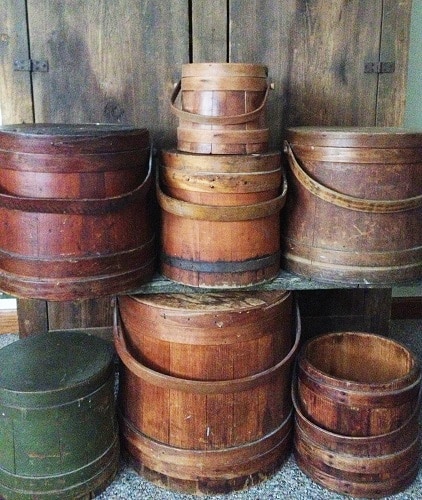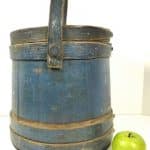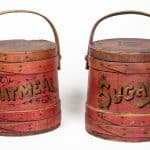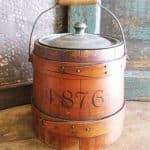Is That a Firkin?
by Jessica Kosinski
When you think of primitive collectibles, one image that might come to mind is that of a lidded wooden container with a handle. Such containers can be found in many homes, especially those with traditional Colonial designs. They make excellent decorations, but what are they exactly? They are known as firkins, and they have had quite a few uses over the years. Let’s take a peek at how firkins came to be and why they are such fun collectibles today.
The Origins of the Word “Firkin”
The word firkin comes from an Old English term. It was originally not the name of an object. It was a unit of measurement. The measurement was quite popular in the 16th century, when it was used to describe amounts of alcoholic beverages, primarily. However, it had slightly different meanings depending on what was being measured and in what country. For example, a firkin of alcohol in England was one quarter of a barrel, but the barrels for certain spirits had different sizes. Therefore, at one point a firkin of beer was equivalent to nine gallons, whereas a firkin of ale was only equivalent to eight gallons. In North America, a firkin was often considered nine gallons, regardless of what was being measured. As time passed, other products were sold by the firkin on both continents as well. Butter was one popular product sold by the firkin. In England, selling cheese by the firkin was also common. Other products measured by the firkin included fish and soap.
Firkin containers themselves were regulated by certain laws in North America and England. Original firkin containers were required to have manufacturer’s marks to identify where they were made. The amount they each could hold also had to be marked on them. The same is not true of many of the wooded, lidded containers we know as firkins today.
As time passed, many people began referring to the containers themselves as firkins. From that point on, the definition of what type of container was considered a firkin slowly changed and expanded. For example, some publications mentioned the use of containers called firkins were used to hold kitchen scraps and garbage. Others talked about men carrying their lunches to work in containers called firkins.
Traditionally, the word “bucket” was used to describe a container used to carry water. The word “pail” referred to an open bucket-like container with a handle used to carry almost anything else. Technically, by original definitions, a container called a “firkin” should not exist. It should be called a “lidded bucket” or “lidded pail.” The popular use of the word “firkin” to describe containers has led to the word being associated today with lidded containers that are usually wooden and have curved handles.
The definition of a firkin container today is still somewhat broad and sometimes depends on location. For example, in areas like New England, where maple trees are prevalent, people commonly refer to the sugar buckets used during maple syrup production as firkins. Primitive maple syrup firkins are used to decorate many New England homes. They can also serve other practical or decorative purposes. Some firkin owners choose to hang them from their handles and fill them with flowers or other decorations. Others use them for the practical purposes of carrying or storing items, as they were originally intended.
For the most part, the value of firkins is subjective. You will not always be able to tell how old they are or who made them. Therefore, it may be difficult, if not impossible, to collect firkins from a particular maker or time period. It is more important to collect firkins based on your love of their appearances. For example, many are painted. Some also feature painted words, such as “sugar” or “cocoa” or decorative designs. One notable exception is that firkins that are proven to be Shaker-made often sell for several hundreds of dollars, while most other firkins have much lower price tags. That is because Shaker firkins were exceptionally well made and had unique designs. They are also somewhat difficult to find.
As with any other collectible, the condition of a firkin can also have an impact on its value. Many firkins are likely to show some signs of wear, such as missing paint, if they were painted to begin with. It is also quite common for the lids of firkins to get lost with the passage of time. Therefore, lidded pieces tend to be more expensive than those without their lids. You should also inspect any firkins you are considering buying to make sure they haven’t been repaired or altered in any way, if you care about authenticity and monetary value. However, if you are buying a firkin to use purely as a fun decoration in your home, small repairs may work in your favor. A repaired firkin is likely to have a lower price tag and may also have the more primitive and well-used appearance you may desire.
Jessica Kosinski has been a freelance writer specializing in writing short articles for 15 years. She is also an avid collector of both antique books and Star Wars memorabilia. Although she is not in the antiques industry professionally, she has learned a lot about antiques over the years by periodically helping out at her mom’s antiques shop in Greenville, NH. She currently balances maintaining the antiques shop’s Facebook page, www.facebook.com/MallofNE, and working on various freelance writing assignments. She can be reached at dementorskiss77@yahoo.com.











Related posts: